MURDER OF JEWS AT BABI YAR WITHOUT PARALLEL
Kiev, Occupied Ukraine · September 29, 1941
By the end of 1940, sixteen months after Adolf Hitler had plunged Europe into war by invading Poland, the number of Jews killed by Nazi Germany approached 100,000. But in 1941 the death toll grew exponentially as mass murder of Jews became state policy. By the end of 1941 roughly one million Jews had lost their lives. In late September of that year, ostensibly in retaliation for a series of bombings that destroyed many buildings in the center of the newly occupied Ukrainian capital, Kiev—buildings that included German Army headquarters and the Hotel Continental, where German officers were billeted—high-ranking German officials in the military and the Nazi Party’s SS (Schutzstaffel) made plans to exterminate the Jews of Kiev and its suburbs. (When the city fell to the Germans on September 19, 1941, over 875,000 people lived there, of whom 20 percent, or 175,000, were Jews.)
Trilingual wall posters all over Kiev ordered Jewish residents to assemble at specified locations at 8 a.m. on this date in 1941. They were to bring with them documents, money, valuables, as well as warm clothes, underwear, and so on. Expecting to be deported to labor camps by train (a rumor to that effect was circulated by the Germans), Kiev’s Jews were instead marched in groups of one hundred to the Babi Yar ravine on the city’s outskirts, ordered to undress, stack their belongings, and then led in groups of ten to the edge of the ravine, where they were machine-gunned by a special team of German SS troops. The executioners were supported by regular German army and police units and some Ukrainian-speaking troops. The massacre of 33,771 Jews on September 29–30, 1941, is considered to be one of the three largest single massacres in the history of the Holocaust and the largest in the history of the Soviet Union. There were 29 known survivors.
In the months that followed, thousands more were seized and taken to Babi Yar, where they were executed. It is estimated that more than 100,000 residents of Kiev of all ethnic groups, mostly civilians, were murdered by the Nazis at Babi Yar. A concentration camp was also built in the Kiev suburb of Syrets (Syrez or Syrezky), several hundred yards from the Babi Yar ravine. The Syrets camp housed prisoners perceived to be opponents of the Nazi regime, mainly Jews. About 25,000 Ukrainians died in the camp.
[amazon_carousel widget_type=”ASINList” width=”600″ height=”200″ title=”Recommended Reading” market_place=”US” shuffle_products=”False” show_border=”False” asin=”0807858633,0674027183,0253222680,1580464882,080324519X,0253222672,0300151276,0813134161,0742544826,0679772685″ /]
Babi Yar, Kiev’s Killing Pit, and Nearby Syrets Concentration Camp
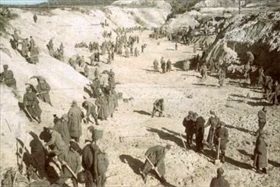 | 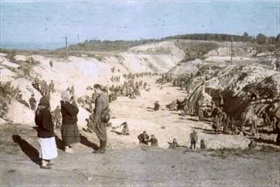 |
Left: Johannes Haehle, a military photographer attached to the German Sixth Army, used a single roll of color film to photograph the aftermath of the Babi Yar massacre early in October 1941. About 300 POWs were taken to the ravine to bury the bodies.
![]()
Right: In this photo camp inmates level the earth over the mass graves. A German soldier in the foreground shows two Ukrainian women the activity in the ravine below. The mass murder of Jews in Kiev lasted until October 3, 1941. During the following months this “Valley of Death” continued to be used as a killing site for Jews, Ukrainian civilians, Soviet POWs, and Roma and Sinti (Gypsies). According to Soviet sources 100,000–200,000 people were murdered at Babi Yar up until November 6, 1943, when the area was liberated by the Red Army. As stated in the “Operations Situation Report of Einsatzgruppe C” of October 7, 1941, the Germans claimed to have shot 33,771 Jews in Kiev between September 29 and 30, 1941.
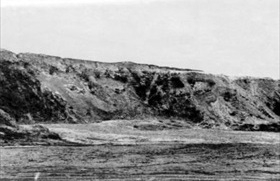 | 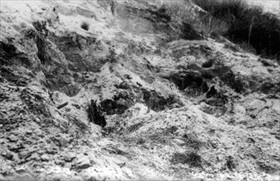 |
Left: Before the Germans retreated from Kiev, they attempted to conceal the atrocities they had committed at Babi Yar. For six weeks from August to September 1943, more than 300 chained prisoners from the Syrets concentration camp were forced to exhume and burn the corpses. On September 29, 1943, 15 prisoners managed to escape. Some 312 of their comrades were killed by the SS during or on completion of the work. This photo and the next one were taken by a Soviet team whose members visited the site after the German retreat from Kiev. Western journalists were also taken to the site. Hundreds of photos like these became exhibits for the prosecution at the postwar International Military Tribunal at Nuremberg.
![]()
Right: Babi Yar’s corpses were cremated on funeral pyres built on iron rails and stood as tall as a two-story house. The piles of corpses were not set on fire at regular intervals. Only when one or more piles were ready were they covered with wood and soaked with oil and gasoline and then ignited. Each funeral pyre took two nights and a day to burn completely. Afterwards the prison detail collected the remaining bones and pulverized them with tombstones taken from the nearby Jewish cemetery. Finally the ashes were inspected in order to collect any remaining silver and gold. The ashes were scattered on farmland in the vicinity.
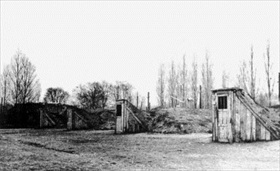 | 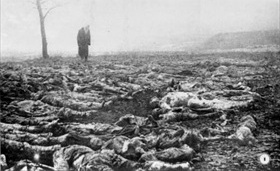 |
Left: Built in June 1942 the Syrets concentration camp was located near the Babi Yar ravine. Men and women were housed in wooden barracks and dugouts with doors and stairs leading below ground, as shown in this photo. The inmates were underfed and many starved to death, with daily mortality of around 10–15 people. Besides Jews, the interned also included Communist Party members, captured Soviet partisans, and Soviet POWs. Inmates began to be evacuated to other camps to the west in September 1943 and in late October the camp was liquidated. About three million Soviet prisoners of war perished in German captivity.
![]()
Right: After the Red Army retook control of Kiev on November 6, 1943, the Syrets concentration camp was converted into a camp for German POWs and operated until 1946. This picture, entered as evidence at the Nuremberg Trials, shows lines of Soviet corpses that had been dug out of the camp’s trash pit.
![]()
Below: Monument to the Murdered Ones in Babi Yar, Kiev, Ukraine. For political reasons an official memorial was not built at the killing site until 1976. The first memorial did not mention that most victims were Jews. The massacre of 33,771 people on September 29–30, 1941, was the largest single mass killing for which the Nazi regime and its collaborators were responsible during their campaign against the Soviet Union. Only ten percent of the Babi Yar dead have been identified.
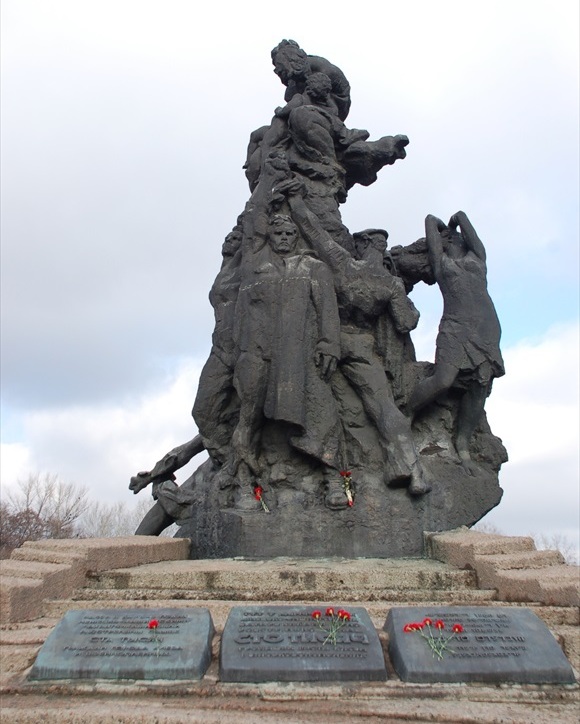 |
Video Memorializing Those Murdered at Babi Yar on September 29–30, 1941
![]()

 History buffs, there is good news! The Daily Chronicles of World War II is now available as an ebook for $4.99 on Amazon.com. Containing a year’s worth of dated entries from this website, the ebook brings the story of this tumultuous era to life in a compelling, authoritative, and succinct manner. Featuring inventive navigation aids, the ebook enables readers to instantly move forward or backward by month and date to different dated entries. Simple and elegant! Click
History buffs, there is good news! The Daily Chronicles of World War II is now available as an ebook for $4.99 on Amazon.com. Containing a year’s worth of dated entries from this website, the ebook brings the story of this tumultuous era to life in a compelling, authoritative, and succinct manner. Featuring inventive navigation aids, the ebook enables readers to instantly move forward or backward by month and date to different dated entries. Simple and elegant! Click 











